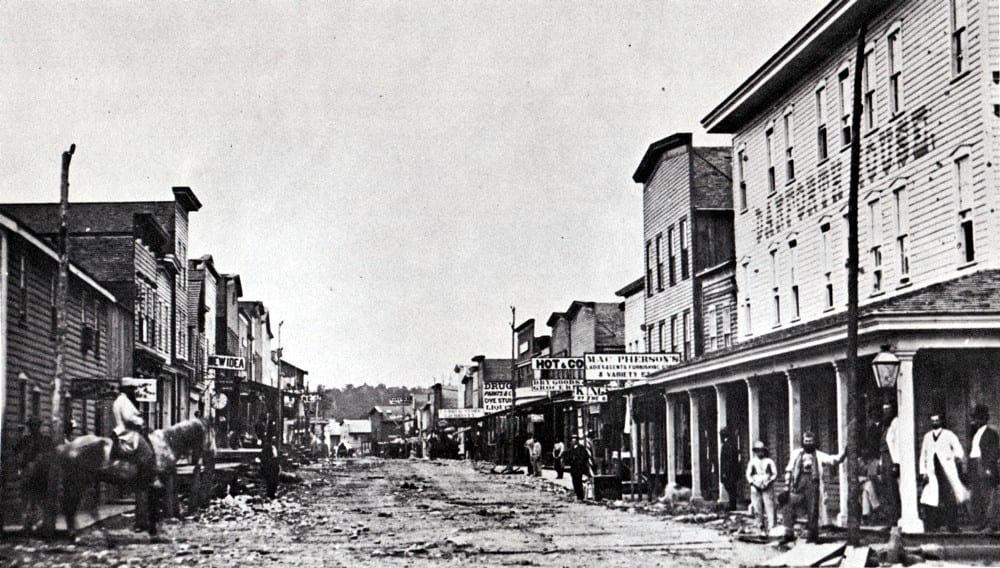Pithole, Pennsylvania: Oil Boom Ghost Town
Following its recent use in a reference request, the title The History of Pithole by Charles C. Leonard, has been digitized and published online. It is now available to read or download through the Lehigh Digital Library.

Historical Background
In the mid-19th century, Pennsylvania was undergoing a massive push for oil. As oil rich areas were discovered, towns and cities would spring up in support. One such city was Pithole, Pennsylvania, which was founded in 1865 as part of the regional oil boom. At its peak between 1865 and 1866, Pithole was home to over 20,000 residents, many of whom were housed in the city’s 54 hotels. The city also boasted Catholic, Methodist, and Presbyterian churches, a daily newspaper, and a 1,100 seat theater.
Following major bank collapses caused by oil speculation and a series of highly destructive fires, Pithole shrank drastically. By December of 1866, the population had dropped over 90% to around 2,000. By the time Pithole was unincorporated as a city in 1877, the population had dropped further still to 237.
Today, Pithole is owned by the Pennsylvania Historical and Museum Commission and is home to the Pithole Visitors Center, which is managed by the Drake Well Museum. Pithole is also listed in the National Register of Historic Places.
The History of Pithole

While the city of Pithole, PA is now mostly an historical footnote, Leonard describes it in the preface as, “No town or city in the world has ever had so remarkable a history as that of Pithole. Its rapid growth, the amount of capital expended, and the fortunes realized here,—its numerous and monster wells, have had no equal since the world began.” This can largely be interpreted as hyperbole but it demonstrates the novelty and momentousness of oil extraction during the mid-nineteenth century.
The body of the book is split into two sections, the first being a history of Pithole and the second a collection of less serious anecdotes concerning the city and its residents. The history section provides an overview of the various petroleum companies active in the area and describes the different oil wells and their unique locales. This section goes into great detail concerning how the wells were constructed, how much oil they produced, and why they were of significance.
Leonard continues the hyperbolic language from the preface by describing Pithole as “Like Rome, sits on seven hills and from its throne of beauty rules the world. This quotation and comparison is not correct, but mistakes will happen in war time.” (P. 35) This section provides listings and descriptions of many of the utilities and businesses operating in the city. Indicative of Pithole’s ultimate demise, Leonard dedicates an entire section to fires. By his account, 17 fires occurred in and around Pithole between August 1865 and December 1866 resulting in damages to oil and property totaling nearly $2 million.
The second section of the book is largely farcical and satirical. It opens with a story titled “Discover of Pithole, in 1865, By Mr. ‘Pit’,” which once again comically exaggerates the cities origins and importance. Other stories include “Remains of Mastodon found on Holmden Street, 1866,” “A Prize Fight,” “War and Bloodshed,” “Ghost No. 1,” and “Ghost No. 2.” The first ghost story alludes to men drinking at night by describing “a fearful and marrow-freezing sound similar to the smashing of bottles and tumblers….Wild shrieks of demonical laughter, accompanied by a hiccoughing sound suggestive of taking poison….” (P. 74) The other stories are similarly tongue-in-cheek.
The final eight pages of the book are advertisements for supposedly oil rich real estate, a bank, the post office, a drug store, a stable, a hotel, the Pithole Daily Record newspaper, and finally a printer. The newspaper boasts a daily circulation of 1,500 copies.
Lehigh University’s Special Collections specializes in the history of technology, an actively growing collection with frequent additions. New and interesting material will continue to be featured on this blog, so check back for updates. If you have any questions or would like more information, contact Special Collections by email at inspc@lehigh.edu or by phone at 610-758-4506.
Leonard, Charles C. The History of Pithole. Pithole City, Pa.: Morton, Longwell & Co., Printers, 1867.